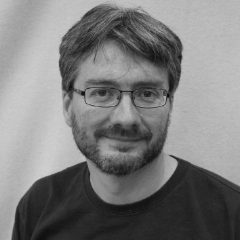A grieving mother tells us of her seven year-old son’s death through drowning. She desperately recounts the moment over-and-over again in the hope that her story will eventually break free of its terrible loop. But the image returns of her child’s body buckling under the pressure of the waves, arms sprawling in the water as if trying to climb an invisible ladder. Quoting the words of South African poet Ingrid Jonker (whose death also occurred through drowning), the stricken mother cries: “I went to seek for the path of my body and could find only the strange scars in the dust.”
However, nothing is quite what it seems in the strangely-familiar world of Dutch composer Michel van der Aa, with its parallel symmetries, involuntary memories and random synchronicities. The mother, impressively sung by soprano Miah Persson (the only ‘real’ character), appears alone on stage, the edgy lines of her sparse musical soliloquy punctuated by nothing other than the sound of pebbles rubbing and scratching against one another. Suddenly, her double appears on screen, luminously hyperreal in 3D. Then another. Replicating the images on screen, the duet becomes a trio of turning, twisting lines that build to a crashing chord when, in abject horror, the mother relives her son’s untimely death once more.
No sooner are we introduced to the mother’s multiple identities than a forty-something man appears on screen, played by baritone Roderick Williams, recounting his own story. Could this be the mother’s son grown old? How is this possible? Who actually died and what really happened?
Blank Out, previously seen in the Netherlands and revived in this year's Festival d'Aix-en-Provence, presents us with fragmentary plot-lines – multiple scenarios that shake the foundations of truth, reality and perception. Of course, the opera’s multimedia dimensions – live performance combined with video, electro-acoustic processing, real-time filming and 3D imaging – only serve to illuminate the illusions thus presented, all reinforced by a model house displayed to the left of the stage, its contents magnified on-screen.
Nevertheless, lying at the core of Van der Aa’s music is an aesthetic that runs counter to the notion of a postmodern condition overloaded with contradictory narratives, multiple images and superficial simulacra. Few composers have managed to articulate today’s crisis of identity with such potent force and individuality as Van der Aa. Alongside earlier striking multimedia works such as One and Up-Close, Blank Out’s characters grapple with ghosts of memories past in order to exorcise a traumatic moment that changed their lives forever.
Despite Blank Out’s bleak scenario, Van der Aa’s music is by no means all gloom and doom. Even the jagged lines of Persson’s opening aria reflects regret rather than outrage. Later, a powerful, pulsing electronic soundtrack is used to generate pace and drama, especially during the instrumental interlude in Scene 3, where a camera shot tracks rapidly across fields and rivers towards the mother and son’s house. The recorded sequences featuring Nederlands Kamerkoor also take on an affective poignancy as the opera unfolds, and at the end of Blank Out one is left with the impression that Van der Aa’s searching music is constantly seeking out those strange scars that lie in the sonic dust, to paraphrase Jonker.
Also featured at this year’s Festival d'Aix-en-Provence is Van der Aa’s ‘mixed reality’ work Eight, where music is combined with virtual reality to create a truly immersive and unforgettable experience. Armed with virtual reality headset and headphones, you are guided through a lifetime of memories through sound and image. It runs until the end of July in the beautiful surroundings of Château La Coste, some ten miles north of Aix-En-Provence, and is highly recommended.




